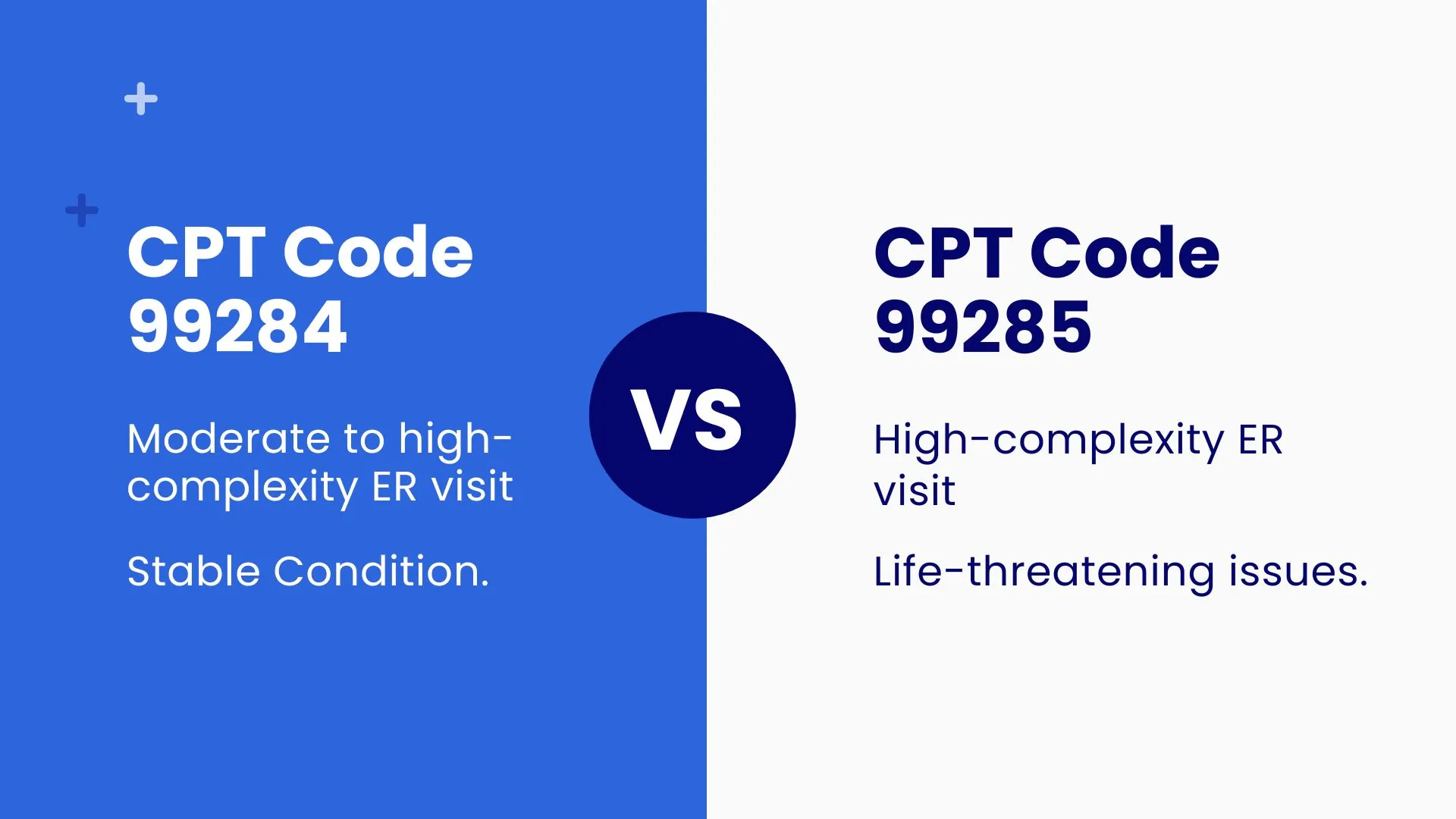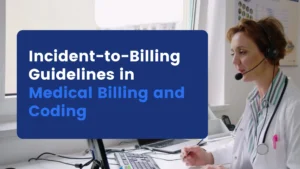Confused about when to use cpt code 99284 vs 99285 in the emergency room? Documenting these codes correctly is key to proper billing and patient care.
When entering a hospital’s emergency room, patients’ conditions can vary from mild to critical, and they need care according to their condition. Documenting the level of care is important for clinicians for clinical precision, but more so for billing and reimbursement. In emergency service departments (ER) two of the most commonly used codes, 99284 and 99285 stand for quite different things but are frequently used. These codes refer to separate E/M (Evaluation and Management) services performed during an ED visit.
This article discusses the similarities and differences between these two codes and explains when and how to use them correctly. this also explains all the main keys which healthcare professionals should know for using these critical codes to avoid any mistakes.
What are Emergency Room CPT Codes?
CPT (Current Procedural Terminology) codes are part of the ED documentation whereby such codes correlate with the level of care provided, the time taken and the medical reasoning by the healthcare professional.
The ED also has its own set of codes, which have a general meaning documented under emergency room exam levels 1-5. These are CPT codes 99281 to 99285 sustained by ER (serviced, not admitted) patients. Each of these levels symbolizes a graded unit of increasing clinical complexity. 99281 means minimal care, while 99285 bears the highest level of ER care.
What Does CPT Code 99284 Mean?
CPT 99284 refers to emergencies in the emergency unit of moderate complexity. It is a common reimbursement code for cases where the patient is stable, however, considerable evaluation, decision making, or procedures need to be undertaken.
99284 CPT code description includes:
· Detailed history
· Moderate complex medical decision making
· A physical examination of moderate depth
· Moderate complexity risk of complications
Typical Cases Where ‘99284’ May Be Used:
· Mild-moderate Asthma attacks
· Abdominal pain that requires imaging
· Dehydration requiring IV fluids
· Minor fractures
· Infections that need lab testing and antibiotic treatment
In such instances, the patient needs to be looked after to a greater degree than the normal one, but does not come in a life-threatening condition.
What Is CPT Code 99285?
The code CPT 99285 is for patients not admitted to hospital but are critically high-risk. It is the highest level of emergency room cpt codes and should be used when providers deliver complex, life-threatening care.
99285 CPT code description includes:
A comprehensive history undertaken
Comprehensive physical examination
High complexity as per the medical decision-making undertaken
Significantly increased risk of death or complications
Common Scenarios for Using 99285:
· Suspected heart attack (chest pain with ECG and cardiac enzymes)
· Stroke-like symptoms needing imaging on the spot
· Severe trauma (e.g., car accidents)
· Sepsis or serious infection with shock manifestations
· Endotracheal intubation or advanced airway control
This code reflects deep clinical activity, quick judgment, and skillful hands.
99284 vs 99285 key differences
Here’s the comparison table, which clarifies the similarities and differences between the two codes
| Category | CPT code 99284 | CPT code 99285 |
| Complexity | Moderate | Very critical |
| Risk factor | Mild | Life threatening |
| History | Detailed | High complex |
| Common scenarios | Ear infections, dehydration, etc. | Heart attack, severe trauma |
| Services provided | Lab tests, imaging, and medicines | Multiple tests, emergency imaging, and quick medication |
Billing and Documentation Suggestions
When high-level services like the procedure code 99285 are billed to clients, critical justification documentation is necessary.
Consider the following while documenting:
· The document is based on medical necessity: Clearly state the reason for evaluation and support it with symptoms, findings, and the decision taken.
· Detail Each Aspect Separately: For CPT code 99285, documentation should reflect numerous decision points, multiple consultations with equally higher-tiered risk assessments.
· Remember, From A Time-Based Approach: While time supports the option, codes are based more on complexity rather than duration spent on the task
· Provide support For Procedures undertaken: Use proper procedural codes if interventions, like endotracheal intubation, were executed on the time of treatment.
· Paying for billing ED consult visits under CPT 99285 should logically lead to the expectation that every single step taken, claims aim at proving the level of care provided. So clearly state every single detail in the document.
Typical Errors while Coding
Under coding – Many providers use 99284 when 99285 is appropriate due to complex decision making or decisions needing complex procedures. This leads to loss of revenue.
Over-coding – Use of 99285 where the documentation does not support high complexity will certainly lead to audit or denial of claims.
Errors from Copy Pasting – Using templates without patient specific updates to the history, exam, or findings poses a significant compliance risk.
Wrong Use of Urgent Care Codes: Some people ask whether urgent care CPT codes include 99285. Usually, they don’t. Most urgent care facilities do not have the capability to manage high complexity, life threatening cases.
When To Apply Other ER Codes
Here is a quick summary of ER CPT codes:
· 99281 CPT code – Very minimal problems: example: a cold.
· CPT code 99282 – Low complexity, such as ear infection or simple laceration.
· 99283 – Moderate complexity, less involved than 99284
· 99284 – Moderate to high level, stable, but needs some level of intervention.
· 99285 – High risk, potentially life-threatening.
What Does Ambulatory Referral Mean in the ED Context?
An ‘ambulatory referral’ describes the step in which a patient is discharged to outpatient follow-up care after being stabilized in the ER. It does not change the code level for purposes of billing. The coding should always reflect the complexity and care provided during the visit, irrespective of referral status.
Related Reading:
77067 CPT Code: Guide to Screening Mammography – Learn how to code and bill bilateral screening mammograms with CAD support.
Final Thoughts
In the field of emergency medicine, the utilization of CPT code 99284 and CPT code 99285 is essential. This ensures that the management of these reimbursed services and ordered by the physicians, accurately reimburses the providers for the complexity and urgency of care rendered.
In simpler terms,
· Moderate conditions that require some form of laboratory tests, imaging, or other methods of care but are not life-threatening fall under 99284.
· Critical life-threatening conditions bound by time and high-risk conditions with complex decision-making processes get 99285.
While choosing the right code does impact reimbursement, in this case, it also serves as an evaluation of the value and intensity of caring rendered at that moment. So, be patient and attentive, and choose the exact code that fulfills all requirements.




